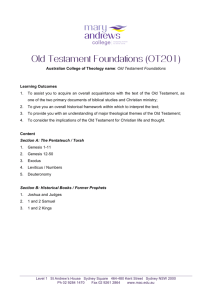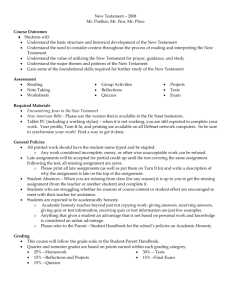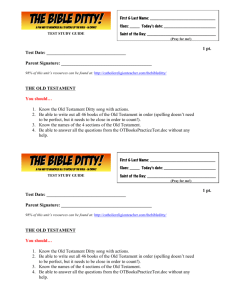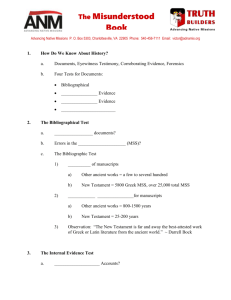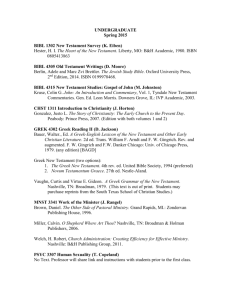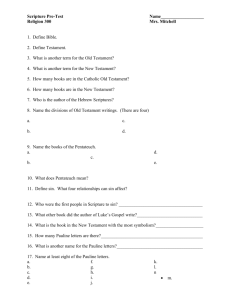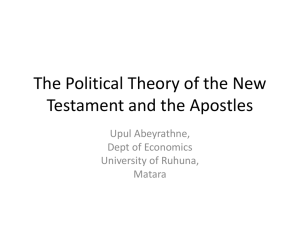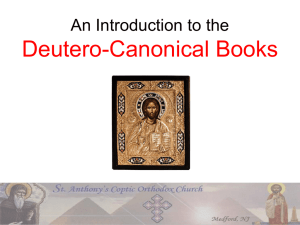Between the Testaments
advertisement
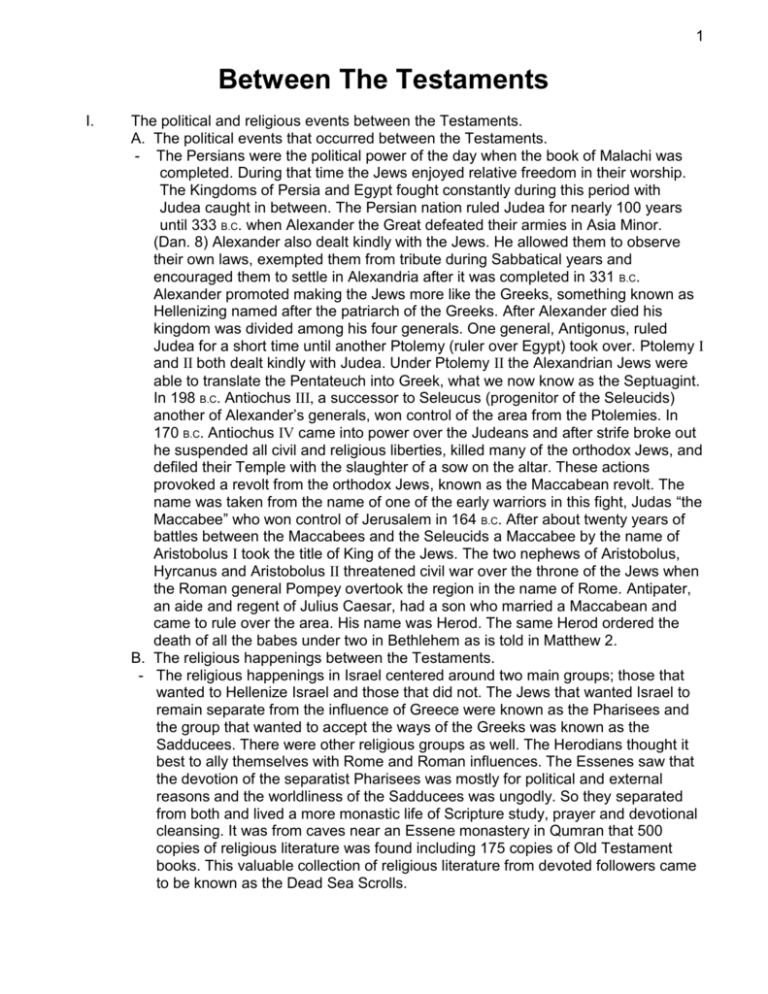
1 Between The Testaments I. The political and religious events between the Testaments. A. The political events that occurred between the Testaments. - The Persians were the political power of the day when the book of Malachi was completed. During that time the Jews enjoyed relative freedom in their worship. The Kingdoms of Persia and Egypt fought constantly during this period with Judea caught in between. The Persian nation ruled Judea for nearly 100 years until 333 B.C. when Alexander the Great defeated their armies in Asia Minor. (Dan. 8) Alexander also dealt kindly with the Jews. He allowed them to observe their own laws, exempted them from tribute during Sabbatical years and encouraged them to settle in Alexandria after it was completed in 331 B.C. Alexander promoted making the Jews more like the Greeks, something known as Hellenizing named after the patriarch of the Greeks. After Alexander died his kingdom was divided among his four generals. One general, Antigonus, ruled Judea for a short time until another Ptolemy (ruler over Egypt) took over. Ptolemy I and II both dealt kindly with Judea. Under Ptolemy II the Alexandrian Jews were able to translate the Pentateuch into Greek, what we now know as the Septuagint. In 198 B.C. Antiochus III, a successor to Seleucus (progenitor of the Seleucids) another of Alexander’s generals, won control of the area from the Ptolemies. In 170 B.C. Antiochus IV came into power over the Judeans and after strife broke out he suspended all civil and religious liberties, killed many of the orthodox Jews, and defiled their Temple with the slaughter of a sow on the altar. These actions provoked a revolt from the orthodox Jews, known as the Maccabean revolt. The name was taken from the name of one of the early warriors in this fight, Judas “the Maccabee” who won control of Jerusalem in 164 B.C. After about twenty years of battles between the Maccabees and the Seleucids a Maccabee by the name of Aristobolus I took the title of King of the Jews. The two nephews of Aristobolus, Hyrcanus and Aristobolus II threatened civil war over the throne of the Jews when the Roman general Pompey overtook the region in the name of Rome. Antipater, an aide and regent of Julius Caesar, had a son who married a Maccabean and came to rule over the area. His name was Herod. The same Herod ordered the death of all the babes under two in Bethlehem as is told in Matthew 2. B. The religious happenings between the Testaments. - The religious happenings in Israel centered around two main groups; those that wanted to Hellenize Israel and those that did not. The Jews that wanted Israel to remain separate from the influence of Greece were known as the Pharisees and the group that wanted to accept the ways of the Greeks was known as the Sadducees. There were other religious groups as well. The Herodians thought it best to ally themselves with Rome and Roman influences. The Essenes saw that the devotion of the separatist Pharisees was mostly for political and external reasons and the worldliness of the Sadducees was ungodly. So they separated from both and lived a more monastic life of Scripture study, prayer and devotional cleansing. It was from caves near an Essene monastery in Qumran that 500 copies of religious literature was found including 175 copies of Old Testament books. This valuable collection of religious literature from devoted followers came to be known as the Dead Sea Scrolls. 2 II. The NON-inspired books of the Apocrypha. - The following books were only accepted by the Roman Catholic Church and are called “The Apocrypha.” The word “Apocrypha” means of hidden or of questionable authenticity. The word came to be known as a connotation for things untrustworthy. The Christian Church NEVER accepted these books as being inspired by God. When the “King James Version” of the Bible was commissioned to be written in 1604 the religious world was dominated by Roman Catholics. For this reason the original work of the “King James Translators” included the Apocrypha in every 1611 version. When a more God-honoring group of scholars took on the work of updating the language of the 1611 King James Version in 1769 they rightly left out the spurious Apocryphal books. The translation that we use and hold dear is the work of those 1769 scholars. The Apocryphal books are divided into four sections: Historical Books, Religious Legends, Wisdom Literature, and Apocalyptic. A. The Historical Books. 1. 1st Esdras – Written ca. (circa or approximately) 100 B.C. – Repeats the same material found in Ezra, Nehemiah, and 2 Chronicles. 2. 1st Macabees – written ca. 140 B.C. – Recounts the patriotic revolt of the Maccabean family against Antiochus Epiphanes and his successors. 3. 2nd Macabees – written ca. 100 B.C. – Covers part of the same period as 1 Maccabees but with heavy moralizing against the Greeks. B. The Books of Religious Legends. 1. Tobit – written ca. 150 B.C. – A tale of a pious blind Jew whose sight was restored. 2. Judith – written ca. 150~100 B.C. – A fictional story of a devout woman who kills an Assyrian general and saves the city from Nebuchadnezzar’s invasion. 3. Additions to Esther – ca. 115 B.C. – Verses inserted throughout the book of Esther including the royal letters and dreams and interpretations. 4. The Prayer of Azariah and The Song of the Three Young Men – written ca. 150~50 B.C. – A prayer, a Psalm of praise and an account of delivery. 5. The story of Susanna – written ca. 150~50 B.C. – Recounts how Susanna was cleared of the false charges of adultery by a young Daniel. 6. Bel and the Dragon – written ca. 150~50 B.C. – Two fictitious tales that include Daniel and his overcoming two false gods of the Assyrians. C. The Books of Wisdom. 1. The Wisdom of Solomon – written ca. 50 B.C. – Contrasts the destinations of the wicked and the righteous, a praise of wisdom and a narrative of Israel’s history in Egypt. 2. Ecclesiasticus (Wisdom of Jesus the Son of Sirach) – written ca. 180 B.C. – A collection of wise sayings similar to the Book of Proverbs. 3. Baruch ( including the Letter of Jeremiah) – written ca. 150~60 B.C. – A work professing to have been written in Babylon by the secretary of the Prophet Jeremiah. 4. The Prayer of Manasses – written ca. 175~25 B.C. – professes to be the prayer of the wicked king of Judah, Manasseh, when he repented and turned to God. D. The Apocalyptic Book. 1. 2nd Esdras – written ca. A.D. 100~250 – Addresses the coming of Messiah, the Roman Empire, and the problem of evil. 3 III. The guidelines used for determining what is an inspired book of the Bible. A. The Old Testament guidelines for what was inspired. 1. The test of authority. - The book must have been written or authorized by a lawgiver or prophet or leader of Israel. Many of these books themselves claimed to be the Word of God. Malachi 4:5 indicates that the prophetic witness would end until the coming of an Elijah-type prophet came. 2. The evidence of the Dead Sea Scrolls. - There were around 500 religious writings found in the Dead Sea caves, many of them copies of Old Testament books or commentaries of the Old Testament books. These writings quoted all of the books we have now in the Old Testament as Scripture but one. 3. The evidence of the New Testament. - All but three of the Old Testament books we have now are referred to as Scripture in the New Testament. All the New Testament Scriptures had the authority of the Lord or an Apostle, so their reference to Old Testament writings as Scripture had their authority as well. B. The New Testament guidelines for what was inspired. 1. The test of authority. - As in the Old Testament, who penned the book or authorized the book’s writing is very important. In the New Testament the book must have been written or authorized by an Apostle. 2. The test of uniqueness. - The book received as inspired had to have internal evidence of a book that was inspired of God. 3. The test of the acceptance by the Churches. - As the books were circulated, the Churches had to accept them as a book that had the hallmarks of an inspired work.
